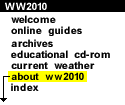
|
Many resources have been implemented here at the Department of Atmospheric Sciences in order to be able to present you with the web server you see in front of you. In order to better understand Weather World 2010, we must reflect upon the past projects that helped inspire us.
It began with Dr. Mohan Ramamurthy and programmer John Kemp creating The Weather Machine in January of 1993. This resource gave users the ability to view weather images through a gopher server. At the same time, Steve Hall began developing instructional modules in HyperCard for use by the educationally motivated Collaborative Visualization (CoVis) Project, a project that strives to promote project based science learning.
With the advent of the first web browser, Mosaic, a new medium for the exchange of information on the Internet was born. As a result, efforts were made to place both the weather and educational resources into HTML format. From the original Weather Machine products, The Daily Planet was created in 1994. It was our first foray into the web world, and soon became a popular site for many to browse.
Meanwhile, the HyperCard based educational modules were converted to HTML by Mythili Sridhar and Steve for use on the web. Mohan, John, and Steve soon came to the realization that the integration of weather data with explanatory and educational material was essential. This brought upon the CoVis sponsored Electronic Textbook, later named the Online Guide to Meteorology, in 1995. This server became an extremely useful location for users to learn about weather with archived data for examples or vice versa. The CoVis Geosciences Web Server was also a useful resource, allowing users large collections of links to all sorts of weather information as well as educational material.
In the summer of 1995, we released the Weather Visualizer, which became one of the most successful realizations of our goal to integrate real-time weather and instructional material. It allowed users to customize their own weather maps. If you wanted a weather map with only isotherms, you checked a box. And if you did not know what an isotherm was, you clicked on the word for an explanation. Seeing the rising popularity of HTML and newer technologies like Java, the fall of 1995 saw the creation of the Image Animator and the Interactive Weather Report, a couple of the first Java weather tools on the web. These allowed real-time instant access to weather data using Java applets, with an even greater degree of educational interactivity.
Early in 1996, the first discussions of a dynamic framework for hypermedia and CD-web interactivity occurred. This possibility was motivated by the difficulties CoVis teachers experienced when trying to access the large volume of information within our educational modules. Often, the connections were too slow for teachers to effectively use our resources in a classroom setting. By being able to place instructional materials on a CD and offer teachers access to the web for weather data, they were much more independent of the web, yet still possessing the ability to use it quickly and efficiently.
With this, and the desire to redesign our resources, including improved graphical interfaces and navigation systems, Steve and Dave Wojtowicz began the construction of the early form of Weather World 2010 in May of 1996. What began then as a quick fix has grown into a much larger undertaking. This new project was to provide a new framework to support these pre-existing modules while simultaneously allowing users access to weather data and information. Steve and Dave realized how quickly the project was growing, so back in October 1996, they presented this project to the students, faculty and staff of the Department of Atmospheric Sciences and asked for volunteers to help them out. With different department members possessing different areas of expertise, the project could draw on these resources to enhance the quality of the web server, while in return, these folks could diversify themselves by learning HTML, developing educational resources and using these skills in a meaningful project. It was a win-win situation.
Well, since October 1996, nearly 20 people have volunteered their time and efforts through a variety of tasks: writing scripts to generate image products, developing helper sections to describe images and fundamental concepts, creating instructional modules and participating in design input and performance testing.
Early on we spent considerable time browsing the Internet, finding what we considered to be the "best" features of web sites available, and incorporating some of these features into our server. Although Java is promising and new technologies are exciting, there are some "fundamental" issues in cyberspace that remain unsolved. Some of these include: easy access to large sets of data and instructional materials, efficient navigation, user interfaces suitable for varying levels of network connectivity and the HUGE problem of maintaining and upgrading the web server once it's up and running. WW2010 is our attempt to address some of these issues plus fulfill our ongoing commitment to explore new and innovative technologies, some of which are being implemented in WW2010.
For a complete listing of related publications, please click here.
For additional information contact: ww2010@atmos.uiuc.edu

welcome |
|

publications |

